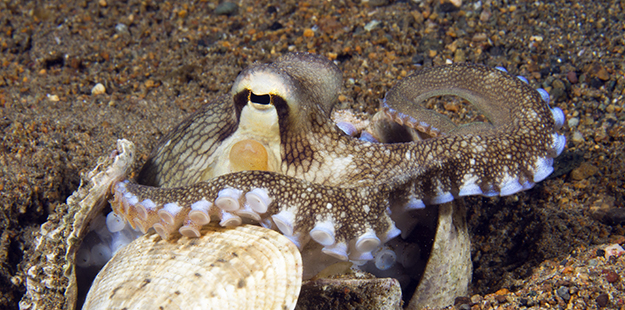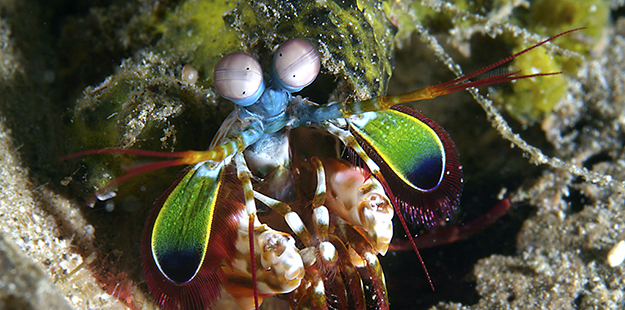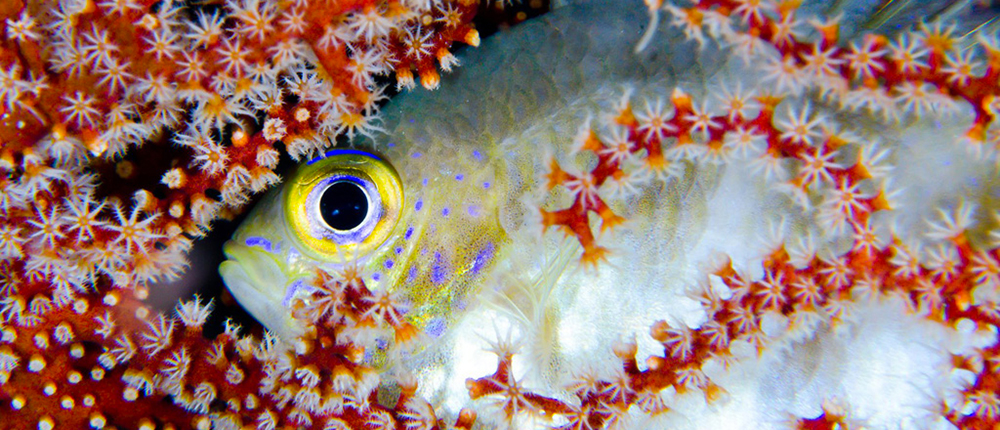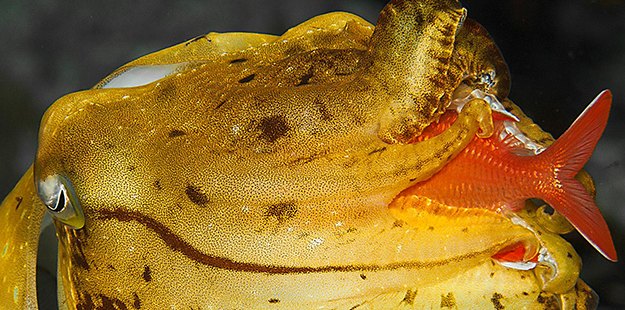Uncommon Senses
A look at the different ways Wakatobi’s marine life perceives the underwater world
Touch, taste, smell, sight, and hearing. Most all living creatures use some combination of these five senses to discover the world around them. But when water is added to the sensory equation, things change. Marine animals often sense the world in ways that are quite different from humans and other land animals. Antennas, eyes, nostrils, gills, tassels… everything has a purpose and plays a special role in what sea dwellers perceive — and it varies from species to species. Some use feet rather than tongues to sample their meals, while others detect noise and vibrations with their skin instead of ears.
Such adaptations may seem bizarre to us topside dwellers, but in the ocean, they provide the sensory advantages needed to find prey, escape predators, or communicate with a potential mate. Let’s take a closer look at some of the unusual ways that marine animals have developed their senses.
Touch
Tactile information is very important to the octopus. Each of its eight tentacles is covered in hundreds of tiny suction discs. These don’t just provide grip, they are also highly sensitive feelers that pick up even the subtlest of sensations. Each disc contains tens of thousands of individual neural receptors, which work together to provide the octopus with extremely detailed information on the nature of the surfaces it encounters.

The octopus’ tiny suction discs provide grip, but are also highly sensitive feelers that pick up even the most subtle sensations. Photo by Walt Stearns
When you see an octopus moving its tentacles across a section of the reef, it is actually building a detailed and nuanced tactile overview of its surroundings. In laboratory conditions, this process has allowed octopuses to solve complex mazes and other spacial puzzles, In the wild, probing comes in handy when identifying suitable environments for nesting, hunting, and mating.

A soothing touch can be a powerful tool for anyone, but especially on the reef, where the cleaners use it to earn their food. Photo by Wayne MacWilliams
Touch plays a different role at the cleaning stations you’ll find on the dive sites of Wakatobi. Just as a massage or facial can prove relaxing to humans, the small fish that provide parasite removal services will fan water and brush against the pelvic and pectoral fins of their clients. They are more likely to provide this touch therapy to predators that are more aggressive by nature, and it is thought that this behavior is used to encourage the client to stay longer for a more thorough cleaning. It may also prevent the client from getting jumpy should the cleaner nip a bit of skin unintentionally during the cleaning process.
Sight
Fish can’t turn their heads to see what’s behind them. This is why many species have eyes on the sides of their heads, which allows them to see in all directions. In the case of blennies and gobies, it also creates some very funny expressions, since these can move each eye independently. They often perch on rocks and coral branches and keep tabs on their surroundings with one eye looking forward, and the other roving to the side and or behind. This behavior can make for some comical portraits.

Gobies can sport some funny expressions. They perch on rocks and coral branches to keep tabs on their surroundings, often with one roving to the side or behind. Photo by Wayne MacWilliams
Some fish have eyes that can see in the ultraviolet light spectrum. A prime example are the damselfish, which not only see the reef in a broader spectrum of colors, they also sport skin patterns that only show up to other fish with ultraviolet sight capabilities. These hidden patterns are thought to be used as a way of identifying others of their species, and as a means of secret communication that can’t be seen by predators that lack UV sight.
At the extreme edge of visual capabilities is the mantis shrimp, which sees the world in ways no other animal can. Each of the shrimp’s globular eyes is divided into three distinct sections that work together to provide trinocular depth perception – we humans only have binocular vision, and need both eyes to accomplish that. It is all but impossible to sneak up on a mantis shrimp, as they have the equivalent of eyes in the back of their head; their eyes are placed on stalks that pivot individually to look forward, back or to the side.

The mantis shrimp is the only known animal in the world to interpret circular-polarized light. Photo by Walt Stearns
Each of the mantis shrimp’s complex eyes contains up to 10,000 visual elements grouped into 16 different types of photoreceptors – 12 more than humans possess. Half of these receptors process what we consider the normal visual light spectrum, the other half interpret ultraviolet and polarized light, including something known as circular-polarized light. Physicists use circular polarization for high-tech radio wave transmissions, and astronomers study it in starlight, but the mantis shrimp is the only known animal in the world to tap into this unique light source. Fitting for an animal with a truly otherworldly appearance.
Smell
The bright colors of Wakatobi’s reefs are lost on some of its inhabitants. Eel have notoriously poor vision, and they don’t hear very well either. Their keen sense of smell, however, can be a thousand times keener than the average reef fish, and rivals that of the best bloodhounds. Key to an eel’s olfactory superiority are the highly-developed nostrils known as nares. As water is pumped through these tube-like organs, millions of sensory cells identify and analyze faint chemical traces in the seawater. Compounds such as amino acids may signal the proximity of potential prey, and the eel will follow these scent trails to locate the next meal.



